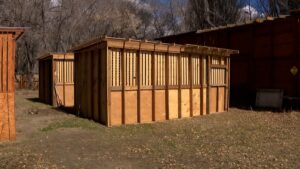PRICE — As the Wildlife Rehabilitation Center of Northern Utah is preparing to move animals out of its current building, two smaller nonprofits are scrambling to help.
One of those nonprofits is the Second Chance Wildlife Rehabilitation in Price. It’s a small organization with just a few volunteers. It is also run in the back of Debbie Pappas’ home, who also serves as the director.
“We’re in rural Utah and it’s hard for us to get people to come and help us here,” Pappas said.
But right now, the organization is having to step up and help. The Wildlife Rehabilitation Center of Northern Utah is being forced to find a new building as Ogden City is making plans for an expansion of the dinosaur park next door. It’s new temporary home won’t be ready until sometime this spring.
Ogden’s dinosaur park to expand, creating challenges for other nearby organizations
It’s a change that Pappas doesn’t really understand. But she says she needs to help even though she’s already full.
Pappas and another smaller rehabilitation center in Mapleton are making room for the animals. They are the only ones licensed in the state to help.
The Utah Division of Wildlife Resources doesn’t do this kind of help, and Pappas says it’s hard to find local help.

Volunteers from Colorado built enclosures to help with the move. An organization from New York built hawk enclosure to help with the extra burden.(Mike Anderson, KSL TV)
However, she is receiving assistance from people outside the state.
Pappas said volunteers from Colorado built enclosures to help with the move. An organization from New York built a hawk enclosure to help with the extra burden.
Over the weekend, Pappas took in seven birds from the Ogden center. In all, Pappas is now taking care of about 30 animals. However, she is worried about the ones that will need help in the near future as the new Ogden center isn’t quite ready to open.
“People calling and finding out, ‘Oh, you’re in Price, I’m not driving that far,’” she said.
Pappas said some animals will be left to die. Or, people may try to help on their own, which doesn’t help the animals, and is illegal.
It’s tough work that never really stops.
“People think why do you do this?” she said. “And it’s like we love this work. It’s for the wildlife. But it’s just very, very, very difficult.”
